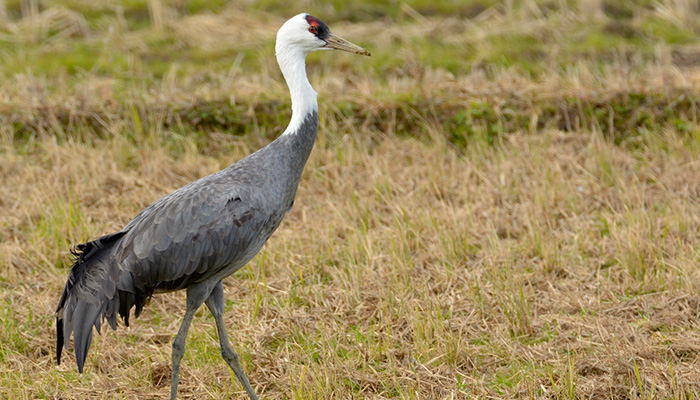
English: Hooded Crane
Russian: Чёрный журавль
German: Monchskranich
French: Grue moine
Mongolian: Хар тогоруу
Japanese: ナベヅル (Nabe-zuru)
Body length: 91-100 cm
Wing span: 160-180 cm
Migration: Apr.-May; Sep.-Oct.
Food: Insects, amphibians, plants, berries,
roots, seeds, and grass.
Status: Very rare species. Accroding to the IUCN Red List categories and
criteria, the species evaluated as-Vulnerable.
Distribution and Range: Breeds in Yakutsk, Primorsk and Khavarovsk in Russia. Winters in
China, Japan and Korea. It migrates to Mongolia for the summer after nesting in
the wetlands of the Siberian coniferous taiga. Large populations with hundreds
of birds are found along the Ulz and Kherlen Rivers. Occurs in the Tsagaan
Sumiin Valley of Arkhangai Aimag.
Habitat: Wetland of taiga. Lakes and river valleys, and adjacent crop
fields.
Population and Threats: About 10 cases of migration and summering were recorded in the
Arkhangai, Overkhangai, Zavkhan areas. In the agricultural fields of Ulz over
700 were estimated in the spring of 1990, and 2079 recorded in 1991, 107
sighted in 1992 and 1891 seen in 1994. At the end of September 1994, over 1000
birds were seen flocked together. Global population abundance estimated at 7 thousand
individuals in the spring 2012, 22 individuals were sighted in the Aikhan Lake
valley. Diminishing water levels in the lakes and ponds where the birds of this
species rest during migration passage or summering affect the species
population.
Conservation Measures: Hunting was prohibited since 1995. Included in the CITES, Annex I
and CMS, Annex II, the Mongolian Red Book (1987, 1997), and the Asia Red Data
Book for Birds (2001). The habitat is partially included within the State
Special Protected Areas.
Further actions: Included in the Mongolian Red List of rare
animals, support and create conditions condusive to stable reproduction,
growth. During the breeding, summering periods of the birds, restrict use of
the lakes with reeds for livestock and summer camp, organize public awareness
programme.